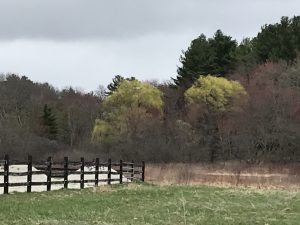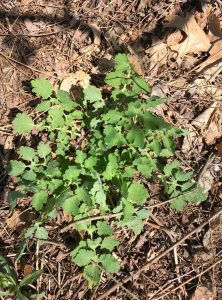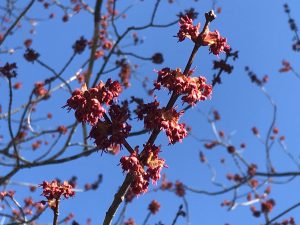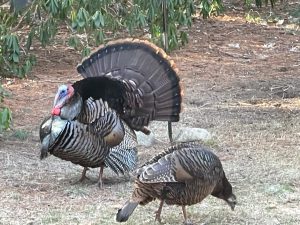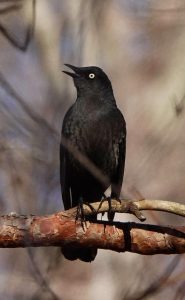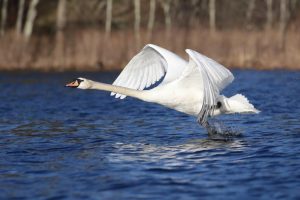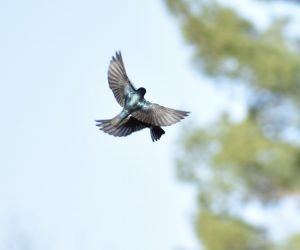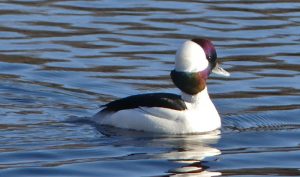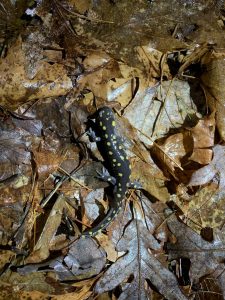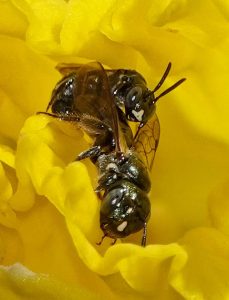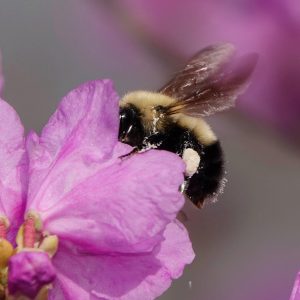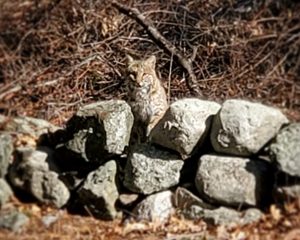Written by Gwyn Loud for the Lincoln Land Conservation Trust. She welcomes your sightings and questions at 781-259-8690 or gwynloud555@gmail.com.
After a week of summer-like temperatures at the end of March we returned to icy mornings the beginning of April. “April showers bring May flowers” and the showers are much needed. We are already in a drought, with rainfall since the beginning of the year more than four inches below normal. The landscape is gradually greening and maples in flower give a reddish cast to woodlands. Red maples, very common here, are dioecious (from Greek, for “two houses”) meaning they have male and female flowers on separate trees. Willows are yellow, the beautiful magnolias by the CCF garden plots are blooming, and numerous shrubs and trees are poised to leaf and flower. Conifers, aspens, birches, maples, and oaks are all wind pollinated and produce great quantities of pollen, as allergy sufferers know well. Professor Douglas Tallamy, entomologist and ecologist, draws our attention to the importance of oaks in his latest book, explaining how oaks more than any other trees promote biodiversity.
Forsythia and daffodils, scilla, and other bulbs bring welcome color to gardens, and flowers to watch for in the woods are ephemerals such as bloodroot and red trillium. Along streams you may find marsh marigolds and in open areas, early dandelions blooming. Garlic mustard, a persistent invasive, is very visible. and easy to pull at this stage. Another common and invasive low green plant along roadsides is greater celandine (different from celandine poppy); it is not yet flowering, but yellow-orange liquid in the stem is diagnostic.
Spring bird migration is well underway and many migrants, such as orioles, vireos, and rose-breasted grosbeaks will arrive over the next month. Chipping sparrows appeared on April 10, and ruby-throated hummingbirds may turn up by May 1, so it’s time to clean your hummingbird feeders. Wood warblers such as pine and palm have arrived, and many more will be passing through soon, some making their way from south and central America. Migration is perilous and research shows that more than 80% of the 3 billion breeding birds lost in North America since 1970 are migratory; the longer the migration, the more dangerous it is. Loss of stop-over habitat, extreme weather events due to climate change, and crashing into brightly-lit buildings in cities are among factors contributing to mortality. Fortunately, some major cities are joining a movement to turn lights out in tall buildings during migration.
Birds are busy courting mates, establishing territories, and starting nests. Pine warblers, Eastern phoebes, and tree swallows have all retuned “on time”, American woodcock have been displaying in a number of places, and overhead we see turkey vultures soaring. Mute swans, which mate for life, are on Farrar Pond and an observer near Beaver Pond watched a pair of swans doing their distinctive courtship ritual. Several people have reported first eggs laid in bluebird boxes and red-tailed hawks have been working on a prominent nest in a large oak on Codman Rd. next to the Police Station. Pileated woodpeckers have been digging a nest hole high in a dead tree along Conant Rd., with wood chips littering the roadside. A friend of mine in PA, Tim Sterrett, also writes a wildlife column and in the latest issue he writes about nests:
“Who built that nest in the birdhouse in the yard? Bluebirds prefer nest boxes out in the open, away from edges and from house wrens. A male House Wren will build a nest in each of the bird houses in the yard unless the houses are far from woods or bushes.
Bluebirds – a neat, dry grass or pine needle nest,
House Wrens – a twig nest,
House Sparrows – a messy nest with a few feathers,
Tree Swallows – a nest with a lot of feathers,
Chickadees – a nest made of moss in a box or tree cavity
Who built a messy nest of dry leaves on a shelf in the garage? Carolina Wrens.
In the wreath left on the front door or at the base of a plant in a hanging flower pot? House Finches.
A woven grass nest in a bush against the house? Cardinals.
A flimsy nest of twigs on a head-high branch of an evergreen? Mourning Doves.
A twig nest lined with grass in the Forsythia bush? Mockingbirds.
Inside a hole in a corner eave of a building or in the dryer vent? Starlings or House Sparrows.
A male bird that nests beside a house may go bananas over a male bird he sees inside the territory he is protecting. The other male is his own reflection in window glass. The reflected bird matches his every aggressive move. Paper (with a pattern that breaks up the reflection) taped to the window may help the male give up attacking his reflected image.”
Several avian species passing through on their way north have been seen, including rusty blackbirds, fox sparrows, and ruby-crowned kinglets. Dark-eyed juncos and white-throated sparrows, which have frequented our feeders all winter, are about to leave us while a few red-breasted nuthatches are still here, as well as some lingering pine siskins. Other recent bird sightings of note include yellow-bellied sapsuckers, singing winter wrens, and red-shouldered hawks. At Drumlin Farm a male Northern harrier called a “gray ghost” was seen, so named because it is all gray above and pure white below, looking ghostly as it soars. Ponds have had visits from ducks such as bufflehead, common and hooded mergansers, ring-necked ducks, wood ducks, and mallards.
Wood frogs, spring peepers, and spotted salamanders migrated to vernal pools in good numbers after dark on March 18 when it was raining and about 40℉, perfect conditions for a “Big Night”. Within a day day the wood frogs and peepers began calling. By now the wood frogs and salamanders are heading back to the upland for the rest of the year, leaving their eggs to hatch and the tadpoles to grow quickly (we hope), before the vernal pools dry up. On any wet night this time of year there can be amphibians on the roads, so please drive carefully. Soon we shall hear the high faint trill of the American toads; they will lay strings of black eggs looking like necklaces in shallow water.
Insects are active now that warmer temperatures have arrived, some more welcome than others, although they all play a role in the ecosystem. Overall declines in insects continue to be worrisome. Many of us have become aware of native wild bees as important pollinators; among the earliest to be seen are cellophane and mining bees, which nest in the ground. Willow catkins provide pollen for various small flies and bees at this time of year and now is when the first queen bumblebees emerge and can be seen cruising close to the ground as they search for suitable holes in which to start their nests. Please check the link below to read about the LLCT’s exciting Lincoln Pollinator Action Plan which is taking place across the town.
Among mammal sightings perhaps the most notable was a bobcat, observed by residents on Forester Rd. Bobcats are very secretive so not often seen, but they are certainly present in our area.
I hope you get outdoors as much as possible to enjoy spring as it unfolds. Just be sure to check for ticks!
Pertinent Links:
- To hear Doug Tallamy talk about oaks: https://awaytogarden.com/oaks-the-most-powerful-plant-of-all-with-doug-tallamy/
- To read about city lights and bird migration: https://www.nytimes.com/2021/04/10/us/bird-migration-lights-out.html?referringSource=articleShare
- To learn about Lincoln’s Pollinator Action Plan: https://lincolnconservation.org/pollinators/action-plan/


